
Sadly, they refused to make them taste like Mr. Sato.
My-Ame is a confectioner that has gained worldwide fame for their detailed versions of Kintaro Ame — small candies that have shapes or words molded into them. This type of candy has been around for quite some time, but My-Ame has built up a special reputation since their establishment in 2007 by global word of mouth.
Then, a video of their production techniques went viral for the incredibly satisfying sensations it produced and netted over five million views.
After that, My-Ame was again in the spotlight after allegations that Daivd Beckham’s son had stood them up on an order for 3,500 candies with the initials “BB.”
Despite that minor setback, business has been booming for these craftsmen with thousands of orders flooding into their Nagoya-based studio from companies, schools, and individuals. So we thought, “why not one more?”
Mr. Sato, who had been in contact with My-Ame during the Brooklyn Beckham debacle, decided to once again place a call, but this time to make an order of 3,500 candies featuring his own face!
He sent a photo of himself to My-Ame and they worked together to choose a design that both captured his highly featured face and could be practically made into a candy. After a few back-and-forth emails, they had reached a compromise.
Mr. Sato also asked to be present during the making of his candies, to which My-Ame generously agreed.
Inside the My-Ame workshop, a team of experienced candy artisans carefully planned the making of the Mr. Sato candies.
It was here Mr. Sato realized that despite the relaxing videos, this procedure is actually quite nerve-racking. The candy needs to be at just the right temperature to work with, leaving only a relatively short window of time to complete it and zero room for error.
This meant the team would have to work together seamlessly like the gears of a watch. Mr. Sato observed them do so with a certain non-verbal communication that only comes with a high degree of skill and experience.
Next, Mr. Sato was called over to the kettle where his candy was currently boiling at 150 degrees Celsius (302 degrees Fahrenheit).
Below the pot is a wide flat metal sheet which cools the mixture.
However, only the metal part cools the candy, so they have to constantly move it around to lower the temperature evenly as seen in the famous video.
The next step involves adding the flavor. There are 12 “standard” flavors to choose from such as strawberry, lemon, or melon. Then there are also 15 “unusual” flavors like cola or coffee. Since you can also mix flavors, there are a lot of options for buyers.
Mr. Sato choose “strawberry milk” for his candy solely because it would be the flavor one would least expect while sucking on his face.
Then the candy is separated and colored. Dye is added to achieve deep and dark colors, but by stretching the candy by hand or machinery, exposure to the air will lighten the hues.
Bit by bit each component of Mr. Sato’s face is assembled. Red and white candy make his mouth…
…white, black, and a skin tone make his eyes…
…and all the individual features are made. It is intricate work, but also a race against the clock, and everything needs to be assembled before the candy cools and hardens.
From here we can see the basic form of Mr. Sato’s head take form. It sort of looks as if our reporter guest-starred on a California Raisins special, broadcast live from the event horizon of a black hole.
Next, the negative space had to be filled in by adding a circular coating of white candy.
With that, Mr. Sato’s face really starts to stand out.
The final layer is the red boarder which is wrapped around the outside of this gigantic candy log.
From there it is loaded into a machine that rotates and stretches it, but the candy looked so huge, Mr. Sato couldn’t imagine this being an easy process.
Nevertheless, the artist began manipulating the end of the candy.
Rather quickly but carefully he began pulling it outward into a much thinner tube.
And just like that, it stretched right out, much easier than Mr. Sato thought it could.
As the candy gets pulled out, it is cut into 20-centimeter (eight-inch) rods.
These tubes are then fed into a machine that slices them into one-centimeter (0.4-inch) candy discs. Quality control is also done at this point to remove any misshapen ones.
And in the end we have a seas of tiny Mr. Sato’s… 3,500 of them to be exact.
At a glance each one looks identical, but because of the twisting and stretching there are slight variations in each face.
Why, this one looks just like the time Mr. Sato ate 350 slices of cheese.
All that was left was to individually wrap all 3,500 candies. Thankfully that part wasn’t done by hand.
From boiling kettle to wrapper the entire process took between 30 and 40 minutes. We condensed it all down to a six-and-a-half-minute video for your pleasure.
It’s an impressively fast feat that must require a considerable amount of knowledge and practice to be able to pull off.
However, the final challenge went to Mr. Sato: what to do with several thousand candies featuring his face?
It’s times like these that Mr. Sato is extremely glad he has a twin brother. As for the remaining thousand or so, since they have an expiry date one year later, the birthdays of everyone Mr. Sato ever knew will be covered well into 2018.
Special thanks to My-Ame
Photos and video: ©SoraNews24
[ Read in Japanese ]



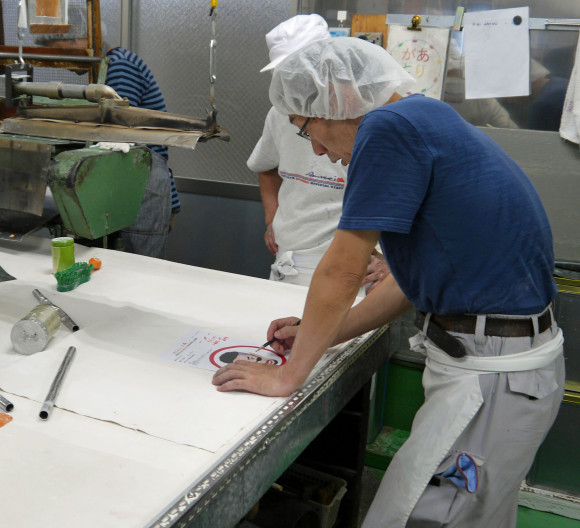



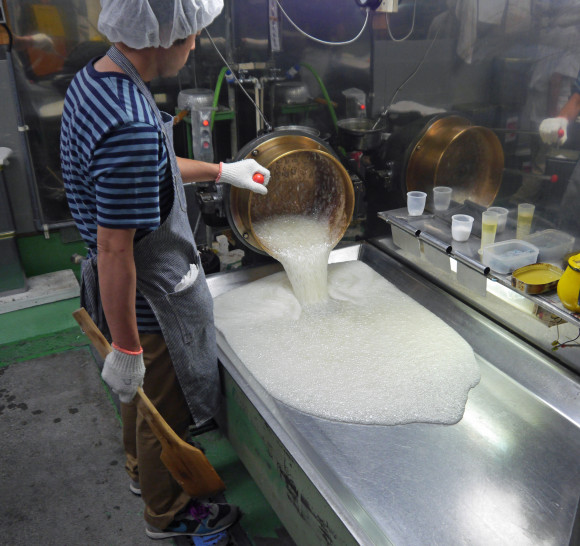



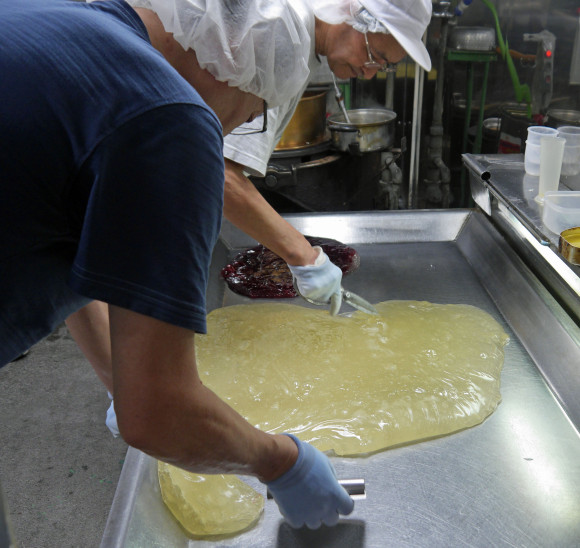















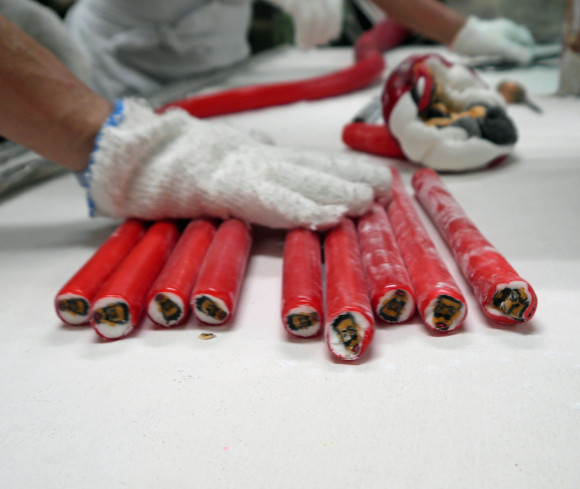



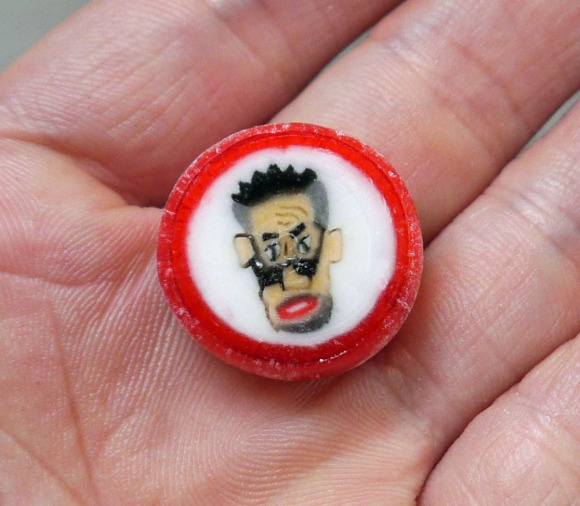


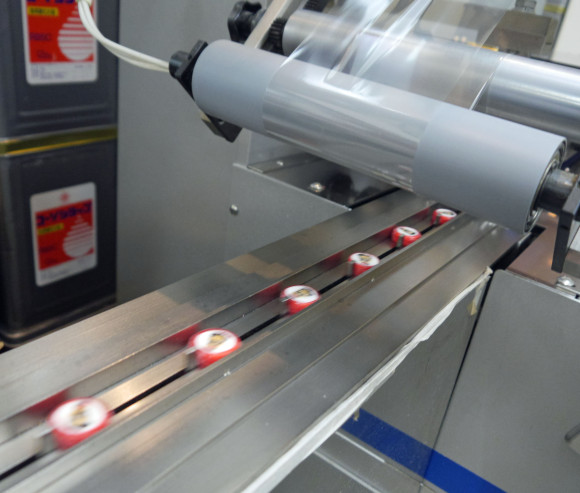

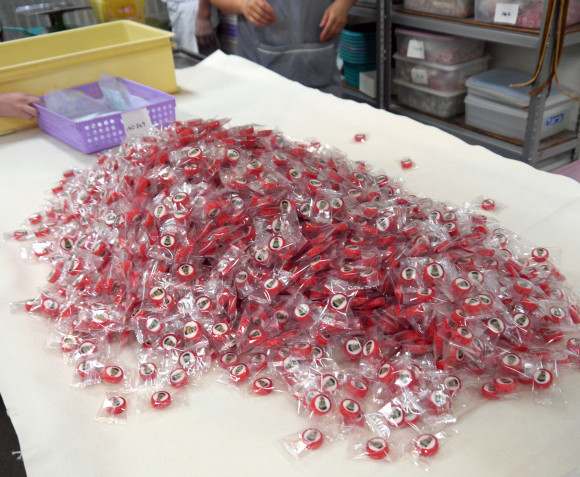

 Brooklyn Beckham orders candy from small artisan sweet company in Japan…with a twist
Brooklyn Beckham orders candy from small artisan sweet company in Japan…with a twist Bontan Ame: the candy that survived 100 years of leaks, bombings, censorship, and floods
Bontan Ame: the candy that survived 100 years of leaks, bombings, censorship, and floods We tried 12 different gummy candies from a Japanese supermarket and found the most delicious one
We tried 12 different gummy candies from a Japanese supermarket and found the most delicious one Mr. Sato participates in beer company’s mysterious “escape game”
Mr. Sato participates in beer company’s mysterious “escape game” Can Mr. Sato freeze this cooling face mask just by shaking it?【Video】
Can Mr. Sato freeze this cooling face mask just by shaking it?【Video】 What makes a good boss in Japan? Workers sound off in survey
What makes a good boss in Japan? Workers sound off in survey Things get heavy with the Gold Lucky Bag from Village Vanguard
Things get heavy with the Gold Lucky Bag from Village Vanguard Cosplay costume room tour by Japan’s number-one cosplayer Enako is an eye-opener【Video】
Cosplay costume room tour by Japan’s number-one cosplayer Enako is an eye-opener【Video】 The Purple Lucky Bag from Village Vanguard is an extra-large waste of money
The Purple Lucky Bag from Village Vanguard is an extra-large waste of money Private booths are coming to Japan’s Shinkansen bullet trains even sooner than we’d thought【Video】
Private booths are coming to Japan’s Shinkansen bullet trains even sooner than we’d thought【Video】 Top Japanese cosplayer Enako returns to Comiket after 6 years, creates mayhem with admirers
Top Japanese cosplayer Enako returns to Comiket after 6 years, creates mayhem with admirers Godzilla-shaped ice cream on sale in Tokyo near the sight his most adorable rampage
Godzilla-shaped ice cream on sale in Tokyo near the sight his most adorable rampage Four Shinto shrines to pray for love at in Japan to start the New Year
Four Shinto shrines to pray for love at in Japan to start the New Year Sony recommends confessing love with a PS5 present, Japanese gamers spot problems with the plan
Sony recommends confessing love with a PS5 present, Japanese gamers spot problems with the plan Japanese Cabinet to officially announce new romanization spelling recommendation next week
Japanese Cabinet to officially announce new romanization spelling recommendation next week Starbucks Japan ready to get Year of the Horse started with adorable drinkware and plushies【Pics】
Starbucks Japan ready to get Year of the Horse started with adorable drinkware and plushies【Pics】 Japanese beef bowl chain Sukiya’s 2026 Smile Box lucky bag basically pays for itself
Japanese beef bowl chain Sukiya’s 2026 Smile Box lucky bag basically pays for itself Hayao Miyazaki says Happy New Year to Studio Ghibli fans with new art for Year of the Horse
Hayao Miyazaki says Happy New Year to Studio Ghibli fans with new art for Year of the Horse Cup Noodle tries an authentic Jiro-style ramen, but something’s not quite right
Cup Noodle tries an authentic Jiro-style ramen, but something’s not quite right The best Starbucks Japan Frappuccinos we want to drink again in 2026
The best Starbucks Japan Frappuccinos we want to drink again in 2026 We revisited Sweets Paradise after a decade to see if Japan’s dessert buffet still delivers
We revisited Sweets Paradise after a decade to see if Japan’s dessert buffet still delivers That time Seiji called JASRAC to ask why he didn’t get paid royalties for his song being on TV
That time Seiji called JASRAC to ask why he didn’t get paid royalties for his song being on TV We found possibly the quietest Japanese-style hotel in Tokyo’s bustling Shinjuku district
We found possibly the quietest Japanese-style hotel in Tokyo’s bustling Shinjuku district Pizza Hut Japan’s hot lucky bags are perfect for a New Year’s pizza party
Pizza Hut Japan’s hot lucky bags are perfect for a New Year’s pizza party Japan’s oldest largetooth sawfish in captivity back on display in Mie Prefecture
Japan’s oldest largetooth sawfish in captivity back on display in Mie Prefecture 7-Eleven Japan starts new temporary luggage storage service in over 300 branches
7-Eleven Japan starts new temporary luggage storage service in over 300 branches Disillusionment at Tsukiji’s tourist-target prices led us to a great ramen restaurant in Tokyo
Disillusionment at Tsukiji’s tourist-target prices led us to a great ramen restaurant in Tokyo Starbucks teams up with 166-year-old Kyoto doll maker for Year of the Horse decorations【Photos】
Starbucks teams up with 166-year-old Kyoto doll maker for Year of the Horse decorations【Photos】 Tokyo considering law requiring more trash cans following litter increase in heavily touristed area
Tokyo considering law requiring more trash cans following litter increase in heavily touristed area Tokyo’s Tsukiji sushi neighborhood asks tour groups to stay away for the rest of the month
Tokyo’s Tsukiji sushi neighborhood asks tour groups to stay away for the rest of the month Tokyo event lets you travel back in time, for free, to celebrate 100 years since Showa era start
Tokyo event lets you travel back in time, for free, to celebrate 100 years since Showa era start Japan may add Japanese language proficiency, lifestyle classes to permanent foreign resident requirements
Japan may add Japanese language proficiency, lifestyle classes to permanent foreign resident requirements Sanrio theme park in Japan announces plans to expand into a Sanrio resort
Sanrio theme park in Japan announces plans to expand into a Sanrio resort Stamina-destroying “Paralysis Noodles” are Tokyo’s newest over-the-top ramen innovation
Stamina-destroying “Paralysis Noodles” are Tokyo’s newest over-the-top ramen innovation Survey asks foreign tourists what bothered them in Japan, more than half gave same answer
Survey asks foreign tourists what bothered them in Japan, more than half gave same answer Japan’s human washing machines will go on sale to general public, demos to be held in Tokyo
Japan’s human washing machines will go on sale to general public, demos to be held in Tokyo Japan’s deadliest food claims more victims, but why do people keep eating it for New Year’s?
Japan’s deadliest food claims more victims, but why do people keep eating it for New Year’s? We deeply regret going into this tunnel on our walk in the mountains of Japan
We deeply regret going into this tunnel on our walk in the mountains of Japan Studio Ghibli releases Kodama forest spirits from Princess Mononoke to light up your home
Studio Ghibli releases Kodama forest spirits from Princess Mononoke to light up your home Major Japanese hotel chain says reservations via overseas booking sites may not be valid
Major Japanese hotel chain says reservations via overseas booking sites may not be valid Put sesame oil in your coffee? Japanese maker says it’s the best way to start your day【Taste test】
Put sesame oil in your coffee? Japanese maker says it’s the best way to start your day【Taste test】 No more using real katana for tourism activities, Japan’s National Police Agency says
No more using real katana for tourism activities, Japan’s National Police Agency says Starbucks Japan reveals new sakura drinkware collection, inspired by evening cherry blossoms
Starbucks Japan reveals new sakura drinkware collection, inspired by evening cherry blossoms Updated cherry blossom forecast shows extra-long sakura season for Japan this year
Updated cherry blossom forecast shows extra-long sakura season for Japan this year What happens when you strap an electric muscle stimulator to your face? Mr. Sato finds out!【Vid】
What happens when you strap an electric muscle stimulator to your face? Mr. Sato finds out!【Vid】 Mr. Sato buys a Japanese snack stocking in Akabane that puts the “stuff” in “stocking stuffer”
Mr. Sato buys a Japanese snack stocking in Akabane that puts the “stuff” in “stocking stuffer” Conbini-talk with Mr. Sato: How to make a convenience store snack 100 times more delicious
Conbini-talk with Mr. Sato: How to make a convenience store snack 100 times more delicious RocketNews24’s Mr. Sato is here to help!【Video】
RocketNews24’s Mr. Sato is here to help!【Video】 SoraNews24’s Mr. Sato declared no longer hot by Google
SoraNews24’s Mr. Sato declared no longer hot by Google The SoraNews24 Work from Home Health Guide: Stretching with Mr. Sato!【Photos】
The SoraNews24 Work from Home Health Guide: Stretching with Mr. Sato!【Photos】 Taste-testing famous ramen from Kobe turns into moment of self-reflection for Mr. Sato
Taste-testing famous ramen from Kobe turns into moment of self-reflection for Mr. Sato Mr. Sato attempts to conquer mountains of shaved ice at all-you-can-eat event
Mr. Sato attempts to conquer mountains of shaved ice at all-you-can-eat event Mr. Sato travels five hours to the Oki Islands to make amends for a 17-year grievance【Photos】
Mr. Sato travels five hours to the Oki Islands to make amends for a 17-year grievance【Photos】 Watch the dying art of the punch perm, a quintessential Japanese hairstyle, in Mr. Sato’s new ‘do
Watch the dying art of the punch perm, a quintessential Japanese hairstyle, in Mr. Sato’s new ‘do Mr. Sato goes post-apocalyptic at Fist of the North Star event
Mr. Sato goes post-apocalyptic at Fist of the North Star event Mr. Sato finally experiences the zenith of bottom-wiping with 5,000 yen luxury toilet paper
Mr. Sato finally experiences the zenith of bottom-wiping with 5,000 yen luxury toilet paper 【Mr. Sato Wisdom】”Anyone who doesn’t take home their disposable chopsticks is a damn fool!”
【Mr. Sato Wisdom】”Anyone who doesn’t take home their disposable chopsticks is a damn fool!” Mr. Sato gives his first ever autograph, gets a broken heart in return
Mr. Sato gives his first ever autograph, gets a broken heart in return Japan’s crazy Air Shield face shield gets strapped to Mr. Sato’s head【Photos】
Japan’s crazy Air Shield face shield gets strapped to Mr. Sato’s head【Photos】 The battle of Elden Ring vs. hard-core casual gamer Mr. Sato
The battle of Elden Ring vs. hard-core casual gamer Mr. Sato
Leave a Reply